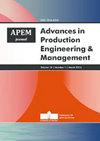一种新的智能制造体系结构模型:与RAMI 4.0参考模型的性能分析与比较
IF 2.8
3区 工程技术
Q2 ENGINEERING, MANUFACTURING
引用次数: 43
摘要
在本文中,我们提出了一种新的智能工厂架构模型,使生产专家能够通过使用工业4.0的所有关键技术,更轻松、更准确地规划新的智能工厂。现有的工业4.0复杂参考体系结构模型(RAMI 4.0)提供了智能工厂体系结构的良好概述,但它导致了一些限制,并且对用户缺乏清晰度。为了克服这些限制,我们开发了一个简单的模型,其中包含智能工厂的整个非常简单的架构,基于具有精确信息和它们之间数据流的分布式系统的概念。与现有的RAMI 4.0模型相比,所提出的架构模型使智能工厂的建模更加可靠和简单。我们的方法改进了现有的智能工厂规划方法,并使所有必要的步骤更加清晰。最后,将本文提出的LASFA (LASIM智能工厂)体系结构模型与现有的RAMI 4.0模型进行了比较。所开发的LASFA模型已在实验室环境中成功实施,用于建设智能工厂演示中心。本文章由计算机程序翻译,如有差异,请以英文原文为准。
A new architecture model for smart manufacturing: A performance analysis and comparison with the RAMI 4.0 reference model
In this paper we proposed a new architectural model of the smart factory to allow production experts to make easier and more exact planning of new, smart factories by using all the key technologies of Industry 4.0. The existing complex reference architectural model of Industry 4.0 (RAMI 4.0) offers a good overview of the smart-factory architecture, but it leads to some limitations and a lack of clarity for the users. To overcome these limitations, we have developed a simple model with the entire and very simple architecture of the smart factory, based on the concept of distributed systems with exact information and the data flows between them. The proposed architectural model enables more reliable and simple modelling of the smart factory than the existing RAMI 4.0 model. Our approach improves the existing methodolo-gy for planning the smart factory and makes all the necessary steps clearer. At the end of the paper a comparison of the proposed architectural model LASFA (LASIM Smart Factory) with the existing RAMI 4.0 model was made. The developed LASFA model was already successfully implemented in the laboratory environment for building the demo centre of a smart factory.
求助全文
通过发布文献求助,成功后即可免费获取论文全文。
去求助
来源期刊

Advances in Production Engineering & Management
ENGINEERING, MANUFACTURINGMATERIALS SCIENC-MATERIALS SCIENCE, MULTIDISCIPLINARY
CiteScore
5.90
自引率
22.20%
发文量
19
期刊介绍:
Advances in Production Engineering & Management (APEM journal) is an interdisciplinary international academic journal published quarterly. The main goal of the APEM journal is to present original, high quality, theoretical and application-oriented research developments in all areas of production engineering and production management to a broad audience of academics and practitioners. In order to bridge the gap between theory and practice, applications based on advanced theory and case studies are particularly welcome. For theoretical papers, their originality and research contributions are the main factors in the evaluation process. General approaches, formalisms, algorithms or techniques should be illustrated with significant applications that demonstrate their applicability to real-world problems. Please note the APEM journal is not intended especially for studying problems in the finance, economics, business, and bank sectors even though the methodology in the paper is quality/project management oriented. Therefore, the papers should include a substantial level of engineering issues in the field of manufacturing engineering.
 求助内容:
求助内容: 应助结果提醒方式:
应助结果提醒方式:


